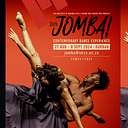JOMBA! Open Horizons: celebrating culture and diversity on the African continent
By Ella-Hope Barrington-Bailey
The theme for the 25th edition of the JOMBA! Contemporary Dance Festival is “(in)tangible heritages”. This was explored on JOMBA’s digital platform, OPEN HORIZONS, where several African dance artists showcased their work responding to this topic through the use of choreography and videography. Within all of the dance pieces, the themes of celebrating one’s culture, and freeing oneself from trauma after discovering one’s heritage are very apparent; both in the use of props, arm movements, costume and setting.
In Tshediso Kabulu’s work, “Exorcism”, he depicts the struggle and eventual success of taking back his own cultural heritage; at first, moving repetitively and erratically with his arms, dressed in all black, running in place in a fixed setting, and shouting to portray his internal struggles, then ending on the beach, in the water, gracefully moving with the waves, and eventually walking away triumphantly, now wearing a symbol of his culture on his head.
Similar to Kabulu’s work, Kamogelo Dooka explores the same topic, but the crown on her head seems to be heavy and weighing her down rather than uplifting her, as she hides behind trees, moving her arms in a way that is both sustained, yet sharp and biting, breathing like a creature waiting to hatch, in dark blue clothing. It seems as though the crown symbolises all she does not know about her culture. Juxtaposed to the darkness of those scenes, like Kabulu, she appears on the beach, coating her hands in sand and skilfully and slowly waving her hands above her, her white dress floating in the wind like the wings of an eagle.
In Zandile Salukazana’s, “Wake Up”, the use of props and arm movements suggests the images of entrapment, as we see Salukazana in a red outfit, her face completely covered in a red rope, only showing one eye. Her arm movements are both repetitive, jagged, and straight lined as if she’s being restricted. This encapsulates the struggle of having her heritage being controlled through someone else’s lens. She manages to take back her culture and heritage on the beach, much like Kabulu’s work, as we look into her eyes, seeing through a lens of her own as she cleverly puts on a pair of glasses to see her heritage in her own way.
Thamsanqa Majela also depicts entrapment, using large moves with his arms; moving, and tapping frantically against the walls in a darkened and confined space, wearing only white pants, as he dances in a graceful, yet tortured manner. Majela does wonders with the timing of his movement, making some of his choreography unexpected and sporadic to display his difficult journey with his trauma and finding out who he is.
Oscar O’Ryan’s “Not From Here”, starts in an interesting place, panning out into a desert-like setting, resembling the atmosphere of Space. We see dancers Farnel Smart, Lee Kotze and the Dance For All InSPIRAtions Youth Dance Company standing in alien like costumes, and they begin to dance with their hands repeatedly going in the same place, in a routine fashion. They are alone in this desert, intentionally illustrating the lonely journey of finding your place and heritage when you are seen as an outsider. Oscar O’Ryan’s videography displays this excellently with the imagery of UFOs and the costume design.
Maulid Owino’s “When Time Stops”, also features being alone when finding your heritage but instead of feeling like an outsider, he seems comfortable in seeing his culture from a place of his own; his movement spiralling in a delicate manner, as time stops or travels faster around him. There are beautiful moments where, he stops moving, staring in awe at the place he is from, looking onward at the people travelling around him. Owino’s piece is a brilliant portrayal of the celebration of culture and heritage, as he floats peacefully in his movement.
OPEN HORIZONS was a wonderful presentation of South African culture and the struggles that South Africans come into contact with when it comes to their identity, and how empowering it feels to come to a realisation of self.
